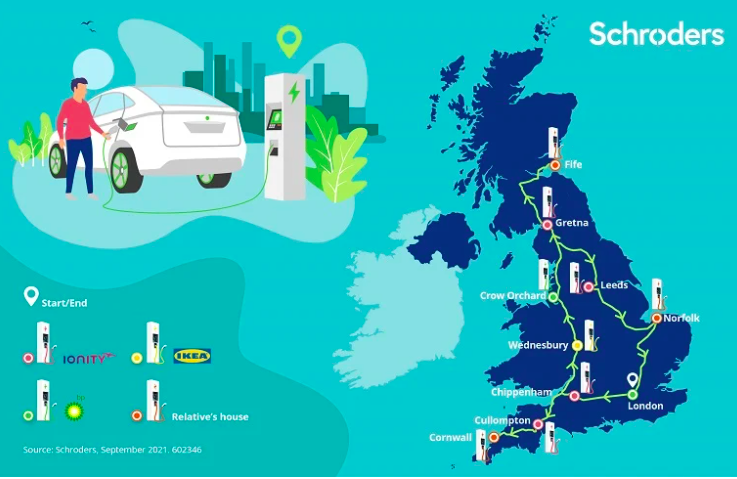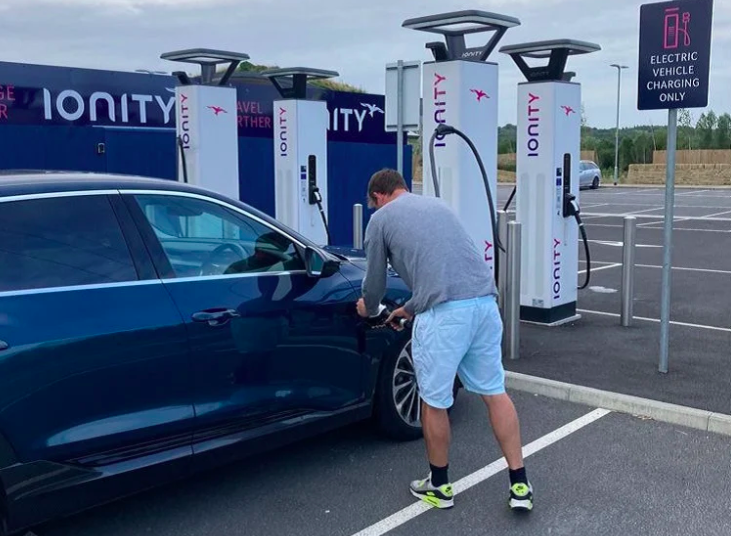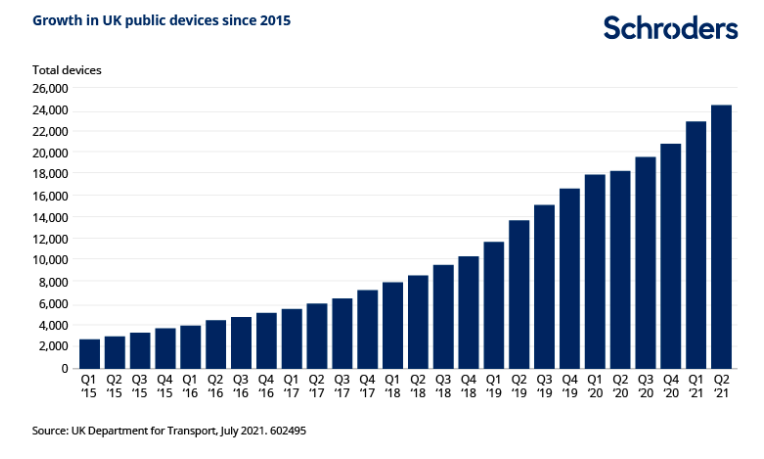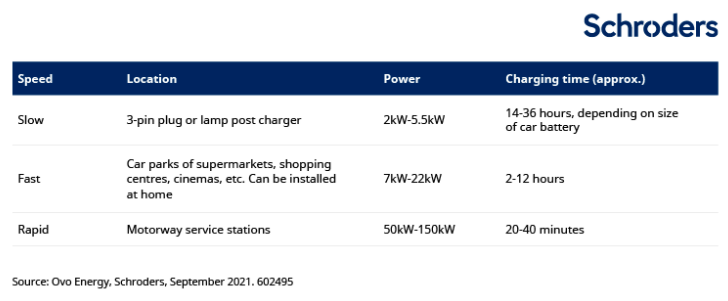
Can EVs really handle a family holiday?

Electric vehicles (EVs) have enjoyed soaring sales in recent years but there are still many EV doubters out there, not least because of the charging infrastructure.
Among them is Allegra Stratton, the UK government’s spokesperson for the upcoming COP26 climate summit. She made headlines by saying she couldn’t use an EV because stopping to recharge means it would be too slow for long journeys, such as from London to north Wales or Scotland to visit family.
And earlier this year Shadow Business Secretary Ed Miliband was caught out on morning television as he called for an “electric car revolution”, but admitted he didn’t yet have one himself. Getting one was a “work in progress” apparently.
However, as an EV owner since 2019, I can vouch for the fact that long drives are not nearly as tricky as some imagine, even with two small children in tow. I offer up my summer holiday tour of the UK as evidence.
Our itinerary: London-Cornwall-Fife-Norfolk-London. The map below shows where we went, including the re-charging stops made along the way. We made this journey over the course of three weeks, with a mixture of holiday and remote working along the way.

Now, I’m not going to pretend a trip like this requires no forward planning. My wife and I were very organised and planned our charging stops in advance. We were also fortunate to stay with relatives in Cornwall, Scotland and Norfolk who have space on their property for us to charge the car.
Discover more at Schroders insights or click the links below:
– Listen: a “code red for humanity” but a green light for investors
– Watch: what is natural capital?
– Read: On a charge or out of juice – can EV charging infrastructure keep up with demand?
Public charging network is expanding
My car is an Audi, a brand owned by Volkswagen. On the map above you can see that most of our charging stops were on the Ionity network, of which we are members.
Ionity is a joint venture between several car manufacturers (Volkswagen’s Audi and Porsche brands, plus BMW, Ford, Hyundai, Mercedes) which is building a high power, rapid charging network on major highways in Europe. The chargers themselves are manufactured by Sweden’s ABB.
Scott charging car at an Ionity charge point

At these kinds of high speed charging points it takes around half an hour to fully charge the car battery. High speed chargers convert AC power from the electricity grid into the DC power needed to charge a car battery.
An advantage of Ionity’s network is that it is compatible with a wide range of EVs. This is not always the case and some vehicles may need adaptors to access non-brand chargers. This can limit the options for drivers and indeed at Chippenham I noticed that the neighbouring Tesla charging station had a queue.
It does raise questions over whether public charging infrastructure is keeping pace with EV adoption but the charging network is continuing to grow. The charts below show quarterly growth in UK public chargers.

When all else fails, the ability to charge at home is still a useful one. We found this when attempting to charge on-site at a hotel in Cornwall, with the BP Pulse station out of order during our visit. Instead, we charged the car at our relative’s house using a three-pin plug with a lead out of the window. This caused some consternation about electricity bills but in fact a full charge is no more than £10.
The problem with charging at home, unless you have a specialist charger fitted as I do, is that it’s very slow. This is because you are using AC power from the grid which a module in the car has to convert to DC.
The table below gives an overview of the types of chargers available and approximate charging times, but much depends on the size of your car’s battery. A three-pin plug could take up to 36 hours for a full charge and therefore is best used when you have ample time.

Switching to EV means switching mindset
But there are still plenty of faster charging options for drivers away from their own homes. One disadvantage of the Ionity network in the UK is the “black hole” around the Birmingham area. We solved this by taking a trip to IKEA. The hour it took to charge the car gave us the opportunity to refuel ourselves too with some Swedish meatballs.
That stop in IKEA was part of our longest day of driving – 577 miles from Cornwall to Fife with four stops. Our return leg from Scotland also involved stops, including overnight in Leeds. A criticism levelled at EVs is that they don’t allow for long drives to be accomplished in one go. That’s true, but there’s an argument to be made for the benefits of stopping.
Firstly, it’s safer; the AA recommends that you take a break from driving every two hours anyway. Secondly, it’s a chance to make the most of the journey, not just the destination. Staying in the unfamiliar surroundings of a Leeds hotel was probably one of the highlights of the whole holiday for the children, and who doesn’t like IKEA meatballs?
Many of us are increasingly cognisant of the need to lead more sustainable lifestyles. Adjusting our mindsets and behaviour is part of this, whether it’s stopping to charge an EV or learning how to mend clothes rather than buying new (see Make do and mend: why fashion needs to look to the past to thrive in the future).
EV infrastructure part of broader shift
It’s clear that both purchasers of EVs and investors in companies who produce EVs need to keep a close eye on the charging infrastructure space. The European Commission recommends one publicly accessible charging point for every 10 EVs but the ratio of EVs to charging stations crept up to 11 in 2020 (source: Statista).
Charging infrastructure will need to keep ramping up as deadlines for phasing out the sale of new internal combustion engine cars approach. For example, Germany had c.45,000 publicly available EV charging stations in 2020, but it’s estimated this will need to rise to 720,000 by 2030 to meet European targets (source: Road2Zero, Statista).
Car manufacturers themselves are very aware of the need for infrastructure, as we can see from the fact Ionity is a joint venture between various car companies. They are not the only ones who have exposure without it being their core business. For example, oil major Royal Dutch Shell runs a network of chargers (Shell Recharge), has its own EV charging company (NewMotion) and recently offered to help UK local authorities finance the installation of 50,000 on-street chargers.
And physical chargers are not the only infrastructure that is required. The electricity being used also needs to be renewably generated and power grids need to be strengthened to cope with extra demand.
This is all part of a change that will see the revamping of Europe’s economy in order to meet climate goals. The European Commission this summer released wide-ranging proposals to cut carbon emissions that will affect virtually every part of the economy. The push towards EVs is just one element of the low carbon future.
Like any new technology, EVs will take time to be broadly adopted. But the barriers to adoption, in terms of infrastructure, are already low, as the example of my trip hopefully demonstrates.
– For more visit Schroders insights and follow Schroders on twitter.
Topics:
Important Information: This communication is marketing material. The views and opinions contained herein are those of the author(s) on this page, and may not necessarily represent views expressed or reflected in other Schroders communications, strategies or funds. This material is intended to be for information purposes only and is not intended as promotional material in any respect. The material is not intended as an offer or solicitation for the purchase or sale of any financial instrument. It is not intended to provide and should not be relied on for accounting, legal or tax advice, or investment recommendations. Reliance should not be placed on the views and information in this document when taking individual investment and/or strategic decisions. Past performance is not a reliable indicator of future results. The value of an investment can go down as well as up and is not guaranteed. All investments involve risks including the risk of possible loss of principal. Information herein is believed to be reliable but Schroders does not warrant its completeness or accuracy. Some information quoted was obtained from external sources we consider to be reliable. No responsibility can be accepted for errors of fact obtained from third parties, and this data may change with market conditions. This does not exclude any duty or liability that Schroders has to its customers under any regulatory system. Regions/ sectors shown for illustrative purposes only and should not be viewed as a recommendation to buy/sell. The opinions in this material include some forecasted views. We believe we are basing our expectations and beliefs on reasonable assumptions within the bounds of what we currently know. However, there is no guarantee than any forecasts or opinions will be realised. These views and opinions may change. To the extent that you are in North America, this content is issued by Schroder Investment Management North America Inc., an indirect wholly owned subsidiary of Schroders plc and SEC registered adviser providing asset management products and services to clients in the US and Canada. For all other users, this content is issued by Schroder Investment Management Limited, 1 London Wall Place, London EC2Y 5AU. Registered No. 1893220 England. Authorised and regulated by the Financial Conduct Authority.
